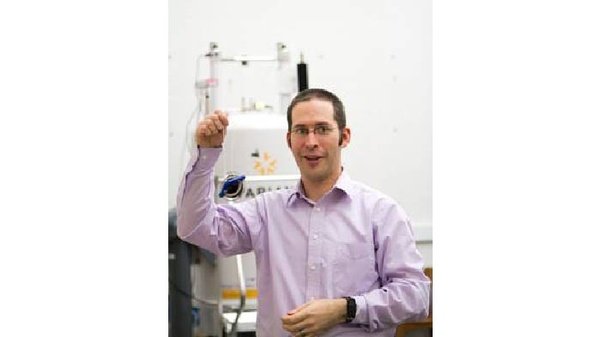NMR Lab Helps Students Understand Molecular Structures
Jan. 17, 2012

Who knew that BYU students had access to magnetic forces 220,000 times stronger than the magnetic field of the earth?
The Nuclear Magnetic Resonance (NMR) facility in the Department of Chemistry and Biochemistry allows undergraduate and graduate students to identify and analyze the shape of molecules.
As manager of the NMR facility, Dr. Scott Burt maintains the NMR instruments, teaches courses that emphasize NMR and trains research students who use NMR in their research. Burt also helps faculty and students apply advanced NMR techniques to research problems in addition to helping them operate the three high-field superconducting NMR instruments.
Students use both two-dimensional and one-dimensional NMR to analyze the structure of a molecule. With two-dimensional NMR, molecular data is plotted on two frequency axes and yields more accurate results compared to one-dimensional NMR.
“To have superconducting instruments that can do two-dimensional NMR, that are full-blown research instruments — that’s a great opportunity for our undergraduates to be learning two-dimensional NMR, one-dimensional NMR and using this to solve real problems,” Burt said.
Burt recently assisted Biology Department professors who had isolated a molecule from a plant that showed exciting anti-viral behavior. The identity of this molecule was unknown, so Burt conducted different NMR experiments, analyzed the data and determined the structure of this novel molecule.
“Now they know what the molecule looks like,” Burt said. “That’s really the power of NMR. . . .”
Nuclear Magnetic Resonance uses the same physics as MRI scanners and is important when conducting research in synthetic and organic chemistry. Radiologists use MRI images to visualize the structure of the brain, cartilage and fluids in the human body. Similarly, chemists interpret NMR spectra to determine the arrangement of atoms in a molecule.
When organic and synthetic chemists attempt to make interesting molecules, NMR allows them to validate the structure of a molecule and determine which atoms are connected to one another.
“The reason NMR is so powerful is it lets you look at connectivities,” Burt said. “By verifying these connectivities, you can say, ‘This is the molecule we have and not any of these other ones.’”
The NMR lab is an indispensable resource to both faculty and students. NMR experiments can be very sophisticated, but once students are trained to interpret the data, it is a fairly straightforward process.
Many schools are unable to provide undergraduate students access to high-field NMR instruments. BYU, on the other hand, has several undergraduate labs that make routine use of the NMR facility, and undergraduate research students have full access to the lab. This gives students valuable research experience while preparing them for future schooling and careers.
“It’s vital to our undergraduate teaching, and it’s vital to our undergraduate and graduate research,” Burt said. “At least one-fourth of our faculty would not be able to do the research they’re doing if we did not have this equipment.”
By Chris Scheitinger, College of Physical and Mathematical Sciences
Photo by Levi Price